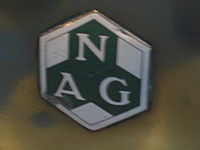Neue Automobil Gesellschaft
 |
|
| Industry | Automotive |
|---|---|
| Fate | Merged with Büssing AG |
| Founded | 1901 |
| Defunct | 1934 |
| Headquarters | Berlin, Germany |
|
Key people
|
Emil Rathenau, founder |
| Products | Automobiles and Trucks |
Neue Automobil-Gesellschaft (NAG) was a German automobile manufacturer in Berlin. In 1915 it was renamed Nationale Automobil-Gesellschaft (NAG).
In 1902, German electrical company AEG purchased the coachbuilding side of Kühlstein under engineer Joseph Vollmer, renaming it NAG. The company's first two cars were reliable, if unoriginal: the two-cylinder Typ A and 5.2 liter (317ci) four-cylinder Typ B, both with chain drive, which resembled contemporary Mercédès. Shortly, an enlarged Typ B2, with 40/45hp (30kW) 7.9-liter (482ci) four, appeared. In 1907, one of these was given to the Empress Auguste Viktoria.
The next year, AEG got out of the car business, but NAG continued alone, introducing a 15 hp (11 kW) 1502 cc (91.7ci) four called Puck, with a remarkable (for the period) ability to rev to 3000 rpm, which may have contributed to its ability to win the Gothenburg Cup at the Swedish Winter Trials in 1912, 1913, and 1914. This sporting reputation was balanced by "aggressively ugly Prince Henry-type bodies".
The Puck would later be developed into a model known in Germany as the Darling. From 1911 to 1914, NAG's standard offering was an 8495 cc (518ci) 60 hp (44.7 kW), joined in 1912-14 by a 1502 cc (91.7ci) 10/12 hp (7.5 kW) K2, 2085 cc (127ci) 14/20 hp (10 kW) K4, 3308 cc (202ci) 20/25 hp (15 kW) K5, and a 5193 cc (317ci) 25/35 hp (19 kW).
During the recovery after World War I, NAG produced smaller numbers of 2.5-liter (153ci) C4s, essentially prewar K4s with new vee radiators replacing the prewar oval ones.
The economic situation was so serious, NAG partnered with Brennabor, Lloyd, and Hansa to form GDA (what in the U.S would be called a trust), to prevent competition from destroying them all. It proved successful for NAG, which prospered, enough to build the C4b sports variant, designed by chief engineer Christian Riecken (a Minerva racing driver prewar).
...
Wikipedia
